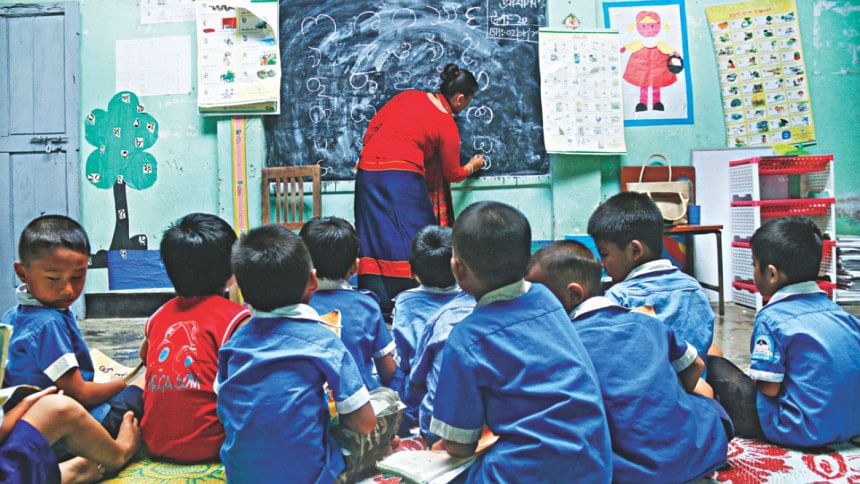Learning in the mother tongue

Whenever we talk about the state of education in Bangladesh, the age-old debate about English versus Bangla medium re-emerges with regard to quality of teaching, affordability, imparting knowledge about Bengali culture, etc. But while many of the broader concerns have merit, the less obvious aspects of the current education system that deserve some serious thinking are often overlooked. The importance of the mother tongue in education is one of them.
In Bangladesh, where the education system is already ridden with multi-faceted challenges, the discussion about incorporating the mother tongue in a child's early learning years is seldom in the limelight. Even amidst the raging debate on the pros and cons of English- and Bangla-medium schools, one rarely ever asks what medium of instruction suits the students best in terms of efficiency of learning and teacher-student communication. The fact is that primary education in the mother tongue is crucial for building a strong foundation for a child's future learning and a growing body of literature in favour of this view is further proof of it.
For the sake of simplicity, let's set aside the sub-par quality of teaching/learning in most of the country's government primary schools and focus on (from a theoretical point of view) the benefits of mother tongue-based learning regardless of whether it's English or Bangla medium. What we are seeing now is that Bangla language skills of primary-school-aged children of both mediums leave a lot to be desired for reasons that go beyond simply the medium of instruction.
The emphasis is on primary education for mother tongue-based learning mainly due to the fact that it is the beginning stage of reading and writing for a child—a critical time period—and learning is far more efficient when a familiar language is the mode of instruction. Simply put, if you speak to a child in a language that he understands, he will absorb the information and express himself better.
In English-medium schools, in particular, where English is the official medium of instruction, Bangla is taught (and learnt) as a subject of its own to primary-aged students rather than it being a mode of communication. As a result, the problem becomes multi-layered. For instance, for a seven or eight-year-old whose first language is Bangla and who is far from grasping the very basics of English, it is only natural for him/her to struggle to learn a totally different subject (math, science) in a language (English) that he/she barely understands.
At a time when the importance of primary education in the first language is increasingly being recognised around the world, in Bangladesh it is yet to gain ground as other, more “serious” problems continue to plague government schools especially—the dismally low teacher to student ratio; lack of qualified teachers (around a third of staff at government schools teach without a Certificate in Education); and extremely poor infrastructure, to name a few. In such a situation, the other not-so-visible factors such as the importance of primary education in the mother tongue go unnoticed.
According to a research paper on the subject titled “The importance of mother tongue-based schooling for educational quality” commissioned by the Education for All Global Monitoring Report, there is actually a term for the type of learning that is now commonplace in different streams of education in the country. It's called “submersion” which essentially refers to “instruction through a language that learners do not speak ... because it is analogous to holding learners under water without teaching them how to swim.”
This is similar to the example I mentioned above in which the problem is actually two-pronged: Not only does the student now have to grasp a new concept but that too in a language other than his/her mother tongue. This is clearly the wrong way and is a recipe for mass confusion for students because, as the aforementioned paper claims, “The second or foreign language…should be taught systematically so that learners can gradually transfer skills from the familiar language to the unfamiliar one.” In other words, skills and concepts that a student learns in his/her mother tongue do not need to be re-taught in the second language—they can simply be transferred. However, it's the technique of “submersion” that has been institutionalised in English-medium schools (hence the name "English-medium") to the extent that we don't really think anything of it. And this mentality is perhaps one of the biggest underlying issues with English-medium schools in the country.
Primary students of Bangla-medium schools on the other hand have the upper hand in that the medium of instruction is familiar to them, but the situation in these schools is worse off due to the utter lack of quality teaching and a learning environment that's anything but conducive. The National Student Assessment carried out by the Directorate of Primary Education revealed some horrifying statistics in terms of learning achievements: two-thirds of class III students and three-fourths of class V students did not meet the desired benchmark in Bangla—the language they supposedly are comfortable expressing themselves in but clearly are incapable of reading and writing well. No, this does not contradict the fact that primary education in the mother tongue is beneficial; rather it only goes to show that there are some serious flaws in the way children are being taught in government schools and the poor quality of teachers in these schools.
All is not bleak however. Last year, the government achieved a significant milestone since for the first time in the country's history textbooks in five indigenous languages—Chakma, Marma, Garo, Sadri and Tripura—were distributed among pre-primary students. And another major accomplishment in the realm of ethnic languages has been the ethno-linguistic survey carried out by the International Mother Language Institute (IMLI)—Bangladesh's first Category II institution recognised by Unesco. The survey, the first of its kind in Bangladesh since Grierson's Linguistic Survey of India during the British era, concluded that there are 40 more languages other than Bangla in the country. This, in light of the textbooks in five indigenous languages distributed last year, tells us that a herculean task awaits us if we are to provide textbooks in all ethnic languages—so far the government has been able to provide pre-primary books in only an eighth (five out of 40) of indigenous languages (that too four years late) even though according to the Education Policy 2010, the government is supposed to provide all textbooks to indigenous students in their mother tongue in pre-primary and class I.
The case of the Santals who were eventually left out of the list of free textbooks in their native language goes to show the myriad complexities when it comes to providing education in the mother tongue. The ongoing debate about the script of the Santal language—Santals are demanding pre-primary textbooks in the Roman alphabet—is what led to their omission from the list. All the resource, technical and bureaucratic hurdles aside, it is their right to demand education in their mother tongue in the script they prefer.
Language is inherently political—and no one knows this better than the Bangladeshi people. We, out of all people, should know that education in the indigenous language is only the first step towards securing the rights of our ethnic minorities in a land where their languages are under threat. The good news is that there seems to be genuine recognition of the importance of education in indigenous languages at the policy level. The bad news is that we are moving at a snail's pace and we still have a lot of ground to cover which, at this point, seems like an impossible feat.
Nahela Nowshin is a member of the editorial team at The Daily Star.





Comments